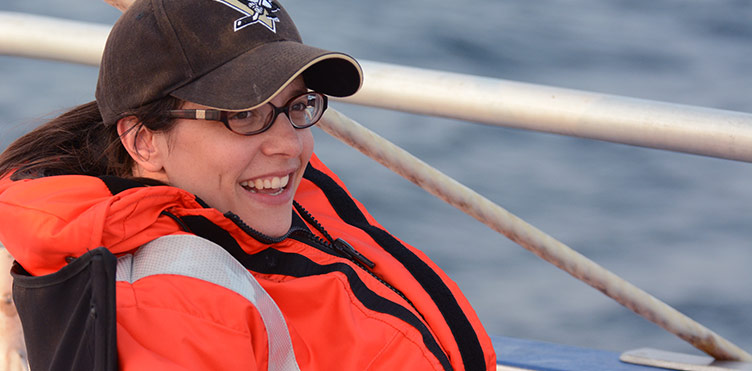
Baleen whale populations in the Gulf of St Lawrence were the focus of two multi-institutional and multi-national projects led by UNB researcher Dr. Kimberley Davies.
Davies, assistant professor on the Saint John campus, led an ocean expedition taking a deeper look at why the North Atlantic right whale is shifting away from traditional summer feeding grounds in the Bay of Fundy in favour of moving north into the Gulf of St. Lawrence.
A new paper co-authored by Davies suggests the whales may have abandoned their traditional feeding grounds due to climate-driven changes in ocean circulation that affect its primary food source, a tiny, rice-sized zooplankter that drifts in ocean currents.
Davies led the expedition to study the foraging ground she and her colleagues helped discover in the Gulf of St. Lawrence in 2015. Right whales are spending significantly more time in the Gulf, where the already-endangered species suffer from ship strikes and fishing gear entanglements. The goal of the expedition was to learn more about how this new environment became a substantial feeding area in recent years.
“Right whales are a specialist predator which means they have a very restricted diet, so until now we believed they were sensitive to changes in the ocean that affect the productivity of this very particular food resource,” said Davies. “However, the oceanographic conditions in this new area are drastically different than in any other known right whale habitat, which suggests the animals may not be quite as sensitive as we previously thought. We need to know more.”
Davies appeared on CBC’s Quirks and Quarks to discuss the team’s research and findings.
Davies is also leading a new study to help identify optimal locations, technology and scientific approaches to maximize the effectiveness of whale monitoring in and around the Honguedo Strait, a major Canadian shipping region, with the goal of mitigating ship strike risk.
The study uses autonomous underwater gliders and fixed moorings, both equipped with digital acoustic monitoring devices, to locate whales in the shipping lanes between Anticosti Island and the northern Gaspé Peninsula in the Gulf of St. Lawrence.
The research team is comprised of Canadian and U.S. researchers, including scientists from UNB, Dalhousie University, Ocean Tracking Network, Woods Hole Oceanographic Inst., JASCO Applied Sciences and Teledyne Webb Research.
“The instruments deployed in early September have performed really well so far and have detected fin and sei whales in the Honguedo Strait,” said Davies. “These data will allow us to measure the presence of endangered whales in and around the shipping corridor and learn how best to use the technology to support ship strike mitigation efforts.”
Transport Canada supported the two-month mission during which the glider, deployed in the Gulf of St. Lawrence near Rivíere-au-Renard on Sept. 1, completed 16-20 transects of a 65km section of the Honguedo Strait. Validated detections will be disseminated via automated systems, including the publicly accessible WhaleMap.
National Geographic published an article on North American right whale deaths written by University of New Brunswick Fredericton alumnus, Tom Cheney.
Cheney’s article focuses on six recent deaths of the critically endangered mammals, which are edging closer to extinction. Only about 400 North Atlantic right whales exist today.
The piece also references research from Davies.
Cheney’s essay can be viewed on National Geographic.